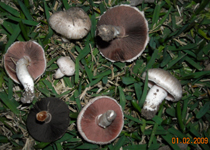What are Molds, Fungi, Mushrooms and Yeasts?
Molds are a group of fungi called "Hyphomycetes", which are chracterized with having filamentous hyphae, and producing airborne spores or conidia (asexual propagules). In nature, molds are decomposers to recycle nature's organic wastes. In medicine, they are the producers of antibiotics.

Fungi are a glomeration of organisms in a separate taxanomic kingdom, in which they differ from Monera (Bacteria), Protista (single-cell eucaryotes mostly), Plants and Animals. Fungi are eucaryotes (with true nuclei in cells) chracterized with having filamentous hyphae, or having yeast forms, obtaining nutrition as decomposers. (For fugal characters, see Facts about Fungi).
Mushrooms are another goup of fungi, which are mainly Basidiomycetes and partially Ascomycetes, both of which share a same feature --having a macroscopic "Fruiting-body, a Mushroom". Fruiting-body is the reproductive organ of the fungus, from which sexual spores are produced and then dispersed either by air or by insects or other animals. All mushrooms are fungi, but only small proportions are edible. It requires an experienced knowledge to know which mushroom is edible, some mushrooms are very deadly.
 Agaricus sp. possibly A. campestris, collected from lawn of Second Baptist Church in Katy, Houston in New Year's Day 2009. Cooked and tasted delicious (Warning: Eating wild mushrooms without knowledge poses great danger).
Agaricus sp. possibly A. campestris, collected from lawn of Second Baptist Church in Katy, Houston in New Year's Day 2009. Cooked and tasted delicious (Warning: Eating wild mushrooms without knowledge poses great danger).Yeasts are fungi, which don't have filamentous hyphae, but in oval or elliptical shapes visible under a microscope. Some fungi could take both the shapes of filamentous or yeast-like, under different conditions, thus those fungi are called "Dimorphic".
